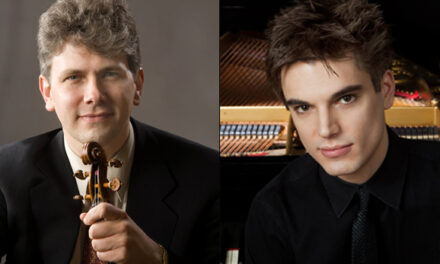Richard Luby first performed the complete cycle of Bach’s Sonatas and Partitas for unaccompanied violin on the UNC campus on a chilly, drizzling Sunday after Thanksgiving in 1985. The Historic Playmakers Theater was virtually unheated and Luby used a Baroque violin, with gut strings, and an apt low pitch (A+415). Between having to constantly retune between each movement due to the cold and humidity and several broken strings, the violinist made enough stray notes to have created a suite of some weird sort! Luby brought his modern violin for this series of concerts, in a reasonably heated Historic Playmaker’s Theater, which spread the cycle over two evenings. Not having to retune so often is a real benefit of using a modern instrument and it allows a better sense of continuity within and between works. The outside weather was almost as bad as on the first occasion.
Luby’s thought-provoking article “Bach’s Two Worlds: Spiritual and Secular?” appeared as a CVNC Preview and served as the Program Notes. This, as well as Robin Stowell’s article “Sonatas and Partitas for solo violin” in Oxford Composer Companions: J. S. Bach, was used for this review. Stowell considers the cycle “the culmination of Baroque polyphonic writing for string instruments,” surpassing previous efforts such as those by H. I. F. von Biber. Luby considers performing the six sonatas and partitas (S. 1001 through S. 1006) “inevitable, given a view that the cycle constitutes a continuum and progression from spiritual struggle and crisis to quiet joy and the depiction of worldly contentment.” In informal remarks to the audience, Luby compared the arch of the cycle from “the stern sermon of the G minor sonata (S. 1001)” to a “midlife crisis” resolving in the E Partita (S. 1006) to enjoy the “quiet pleasures of everyday life.” He also alluded to the Theory of Affects, originally derived from Classical Greek and Roman doctrines of rhetoric and oratory. Composers were supposed to move the “affects” (emotions) of the listener.
This concert consisted of Sonata I in G minor, Partita I in B minor, and Sonata II in A minor. Both Luby & Stowell point out the sonatas reflect the “slow−fast─slow─fast” movement structure of the early Sonata da Chiesa which originally was inserted into a church service. The Partitas are modeled after secular Sonata da Camera which consisted of a series of dance movements. Each sonata is closely paired with the partita which follows it. Luby regards the sonatas as “sermons” and the partitas as “symbolic life-dances” representing “the worldly sphere in which even the most spiritually-minded must dwell.” Among the difficult technical demands Bach makes, Stowell considers “particularly significant his lavish use of multiple stopping to sustain a complete polyphonic texture.” Bach creates the illusion of more than one instrument playing by “his exploitation of ‘polyphonic melody,’ in which a single line is made to suggest a fuller texture by constantly shifting between implied voices.” The G minor sonata consists of an improvisatory prelude followed by an extended fugue, “the latter continually alternating between strict polyphony and single-line passage work.” A lilting dotted rhythm dominates the slow “Siciliana,” which is followed by a lively paced “Presto” finale. The B minor Partita is made up of four movements “Allemanda-Corrente-Sarabande-Tempo di Bouree” each of which, according to Stowell “incorporates a simple variation (double) usually in a faster tempo.” Stowell points out the imposing Fugue of the A minor sonata stands in striking contrast to the contemplative, peaceful mood of the “Andante” with its “insistent dotted rhythms.” This sonata, paired with its D minor Partita (to be played on the next concert), make up Luby’s “mid-life crisis” portion of the cycle.
Luby played this program with fine intonation and a warm tone. Multiple stops came off beautifully as did Bach’s intended sustained effects. The absence of multiple interruptions to retune greatly aided the sense of an over-arching linkage. He captured the overall “affects” Bach might have planned very well. Rhythms, especially in the dance-named movements, were strongly characterized, vital and very enjoyable. Dynamics were effectively chosen and articulations in the fastest passages were outstanding.
(For a review of concert II, click here.)











